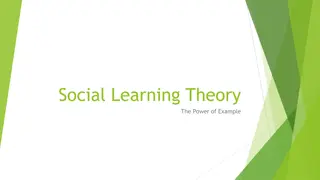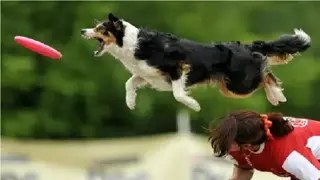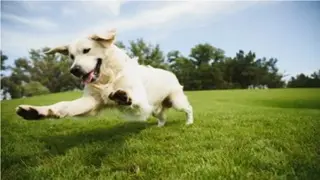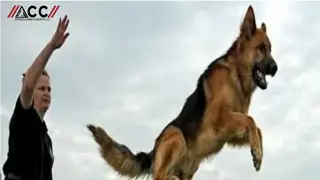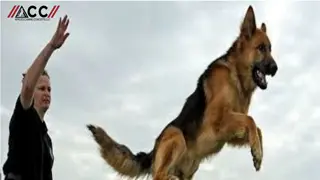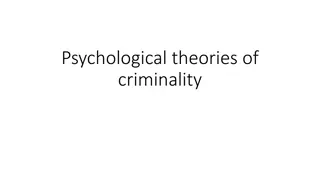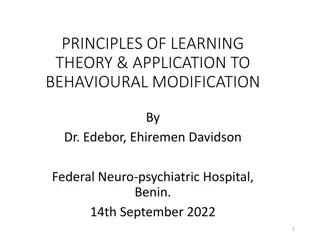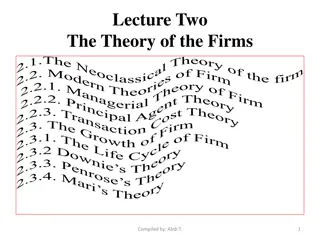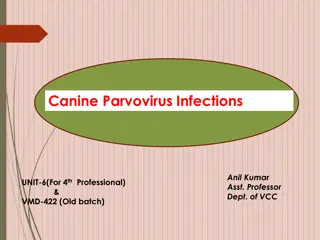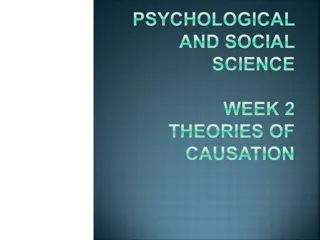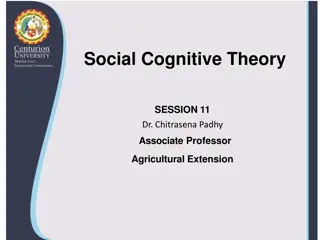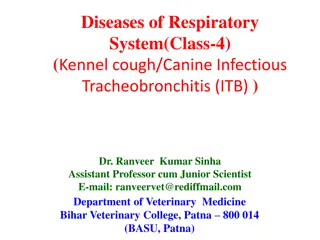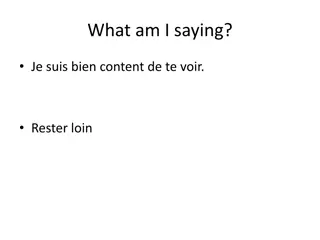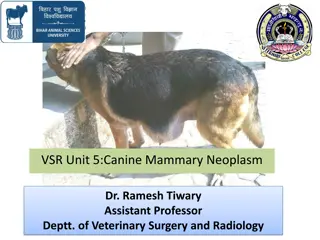Canine Learning Theory and Training
This course delves into operant conditioning of domestic dogs, covering classical and modern behavior analysis. Explore canine behavior, communication, and social interactions. Learn to apply learning theory through ABA to teach obedience skills, address behavioral issues, and enhance shelter dog readiness. Discover the rights of dogs and methods like positive reinforcement and clicker training to ensure their well-being and adoption readiness.
Download Presentation

Please find below an Image/Link to download the presentation.
The content on the website is provided AS IS for your information and personal use only. It may not be sold, licensed, or shared on other websites without obtaining consent from the author.If you encounter any issues during the download, it is possible that the publisher has removed the file from their server.
You are allowed to download the files provided on this website for personal or commercial use, subject to the condition that they are used lawfully. All files are the property of their respective owners.
The content on the website is provided AS IS for your information and personal use only. It may not be sold, licensed, or shared on other websites without obtaining consent from the author.
E N D
Presentation Transcript
Operant Conditioning of Canis lupis familiaris That is, training the domestic dog!
This course is 3-fold To learn and understand basic learning theory including: Classical conditioning Operant conditioning Modern Behavior Analysis To understand the behavior of the domestic canine: Behavioral signaling and communication Development of the species and the individual dog Social behavior of the domestic dog, including dog to dog and dog to human interactions To apply basic learning theory through applied behavior analysis (ABA) to: Teach basic obedience skills remediate behavioral issues prepare shelter dogs for adoption
The Rights of Dogs Freedom from hunger and thirst Freedom from pain Freedom from discomfort Freedom from avoidable or treatable illness and disability Freedom to be themselves Freedom to express normal behavior Freedom to exercise choice and control Freedom to frolic and have fun Freedom to have privacy and safe zones Mark Bekoff & Jessica Pierce, Unleashing Your Dog: A Field Guide to Giving Your Canine Companion the Best Life Possible 2019
How do we do this? Begin with an overview of learning theory Learn the techniques of positive reinforcement based teaching and Clicker training Begin to interact with our dogs and apply our lecture-based and readings-based knowledge as we assist our dogs in becoming adoption ready!
Lets start with some basic theory! Classical vs. Operant Conditioning
Clicker training is based on the Science of Operant Conditioning Both study how living organisms learn about contingencies. ABC s of behavior. Antecedents: what is/are the setting condition(s)? Behavior: what behavior is emitted? Consequences: what consequences maintain the response? Emerged from area of psychology called Behavior Analysis Experimental Analysis of Behavior Applied Behavior Analysis
Defining learning Classical conditioning is pairing a predictive stimulus with a predicted event: CS US UR CR You respond because a stimulus signals an upcoming event Do NOT have to respond Learning is . A relatively permanent change in behavior not due to maturation but to experience and/or practice. A learned behavior is predictable Operant conditioning: Pairing a consequence with a behavior R C Can add a predictive stimulus: S+: R C Animal MUST engage in the response in order to receive the consequence For our class we will concentrate on 2 kinds of learning
Pavlovs Contribution Ivan Pavlov Russian physiologist: Studied salivation 1901: discovered and wrote about classical conditioning Found that his dogs reacted to both his presence and the time of day for feeding/experimentation Research emerged out of this observation: Measured amount of salivation during baseline: Present food to dogs Measure slobber Then added a predictive stimulus: a Bell Presented the Bell Food Measured slobber to see if dogs would begin to slobber to the bell
Labeled each part of these events: Unconditioned stimulus or US: The stimulus that automatically elicited the behavior (usually innate) E.g., the food elicited the slobber Conditioned stimulus or CS: The stimulus that predicts the US Is a learned (thus conditioned) stimulus Conditioned response or CR: The behavior that occurs to the CS Often very similar to the unconditioned response Occurs because the CS predicts the US Unconditioned response or UR The behavior that is automatically elicited Unlearned; often reflexive
Classical Conditioning Procedure CS US UR Bell Food Slobber CR Digestive enzymes Slobber with less
Classical Conditioning learning curve The CR does not just suddenly Strength or magnitude of 120 100 80 Appear, rather it takes several trials or sessions to learn the connection CR 60 40 20 0 1 4 7 10 13 16 19 22 25 28 31 34 37 40 43 46 49 52 55 58 61 64 Trials Between the CS and the US
Several important characteristics Compensatory Response: The CR is not always identical to the UR .and even can be opposite. Strength of the CR: The CR gets stronger with more pairings. Extinction: The CR gets weaker if you stop the CS-US pairings. Not forget, but habituates Spontaneous Recovery: If similar settings occur to the original CS-US setting, even an extinguished CR may reappear. Relearning: An extinguished CR can be more easily relearned than a new CS-US pairing Generalization and Discrimination: A CR will generalize to similar CSs, but one can also learn to discriminateto a particular CS.
How can we use CC? Behavior Adjustment Therapy (BAT) Really just systematic desensitization Dog associates other dogs or persons with emotional distress The Clicker: Dog performs correct behavior We click Dog gets a treat Clicker becomes associated with food: Click predicts treat! We REPLACE the emotional distress with positive event OLD learning: OTHER DOG Bad things Bark, lunge, emotional distress Clicker becomes a conditioned stimulus or CUE for the dog We replace this: OTHER DOG Treat/pets/good things Looks for a treat. Relaxed state.
Operant Conditioning: The Law of Effect Law of Effect emerged from this research: When a response is followed by a satisfying state of affairs, that response will increase in frequency. Thorndike (1911): Animal Intelligence Experimented with cats Put cats in a puzzle box Cats had to figure out how to pull/push/move lever to get out; when out got reward The cats got faster and faster with each trial
Skinners version of the Law of Effect Had two problems with Thorndike s law: Defining satisfying state of affairs Defining increase in behavior Used words reinforcer andpunisher Idea of reinforcer is strengthening of relation between a response (R) and a reinforce (Sr) Rewrote the law to be more specific: When a response is followed by a reinforcer, the probability of occurrence of that response will increase. Punishers are weakening the strength of the relation between a response (R) and a punisher (P)
Skinners Reinforcement and Punishment Defined reinforcement and punishment: Also noted could deliver reinforcers and punishers in TWO ways: A reinforcer is any stimulus which increases the probability of a response when delivered contingently Add something: positive or + Take away something: negative or - A punisher is any stimulus which decreases the probability of a response when delivered contingently
Reinforcers vs. Punishers Positive vs. Negative Positive: something is ADDED to environment Reinforcer = rate of response INCREASES Negative: something is TAKEN AWAY from environment Punisher = rate of response DECREASES Can make a 4x4 contingency table
The 2 x 2 contingency Table Reinforcers ALWAYS INCREASE a target response Punishers ALWAYS DECREASE a target response
Several important characteristics Strength of the Response: The R gets stronger with R-Sr pairings. Spontaneous Recovery: If similar settings occur to the original R-Sr setting, even an extinguished R may reappear. Relearning: An extinguished R can be more easily relearned than a new CS-US pairing
Several important characteristics Extinction: A bit Different The R gets weaker if you stop the R-Sr pairings BUT it will increase in intensity before it weakens Transitory increase in the rate or responding Extinction induced aggression
More parameters: Generalization can occur: Operant response may occur in situations similar to the one in which originally trained Can learn to behavior in many similar settings Discriminationcan occur Operant response can be trained to very specific stimuli Only exhibit response under specific situations Can use a cue to teach animal: S+ or SD : contingency in place S- or S : contingency not in place Thus: SD: R Sr
Schedules of Reinforcement: Continuous reinforcement: Reinforce every single time the animal performs the response Use for teaching the animal the contingency Problem: Satiation Partial reinforcement Solution: only reinforce occasionally Can reinforce occasionally based on time Can reinforce occasionally based on amount Can make it predictable or unpredictable
Partial Reinforcement Schedules Fixed Ratio:every nth response is reinforced Fixed interval:the first response after x amount of time is reinforced Variable ratio:on average of every nth response is reinforced Variable interval:the first response after an average of x amount of time is reinforced
Fixed Ratio and Fixed Interval Variable ratio and variable interval Cumulative records
Why is all this important? We will be teaching dogs basic obedience and leisure skills We will be using operant conditioning, and more specifically, clicker training and TAGteach Clicker training is the use of a marker to tell the dog when it does the right behavior You watch for the behavior You click when the behavior occurs You REWARD (always) following the click
Clicker Training With clicker training there are several important concepts: We use clicker training to shape new behaviors Create chains of behavior: More than one behavior may occur in order to get the click Partial Reinforcement: We will wean the dog off the clicker using the schedules of reinforcement
Clicker Training System of training/teaching that uses positive reinforcement in combination with an event marker The event marker (click) marks the response as correct
Clicker Training You WATCH for the behavior to occur Clicker = Precise tool: an event marker WAIT for the behavior or approximation of that behavior Don t lure or force The click pinpoints a behavioral instance Informs the animal that that was the correct targeted response MARK the behavior: Click when the behavior is occurring to signal to the animal yes, do THAT! After marking the behavior, REINFORCE the response!!
Dogs Depend on YOU! During Tuesday lectures we will: Learn the theory of operant conditioning Learn about our organism: the domestic dog We will have some resident lab dogs that will help us learn techniques During our labs : We will apply our information that we learn in the classroom with each other and with the dogs. We will have some resident dogs that we can use for teaching advanced behaviors Deaf and deaf/blind dogs for a challenge Rescue dogs to apply our basic skills YOU will be working primarily with rescue dogs (ages 8 weeks to elderly) We have an exciting opportunity to work with Pet Central Helps on Wiley Drive YOUR job is to prepare these dogs for adoption! Are you ready to do this?




